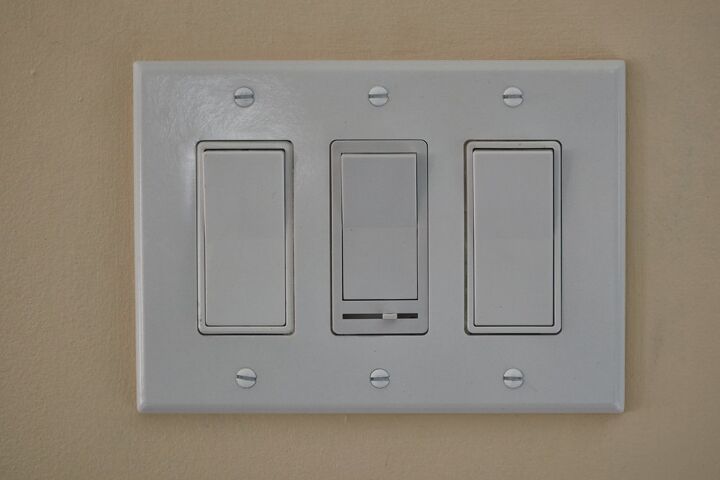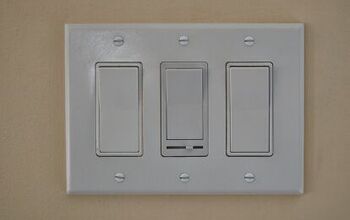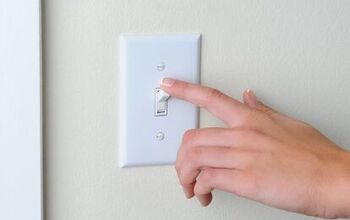Why Are Dimmer Switches So Expensive? (Find Out Now!)

Have you ever been in a room that was too bright, and you wished that you could tone down the brightness of the room’s light? If so, then you would need a dimmer switch to do that. Dimmer switches are a commodity that doesn’t come as standard procedure on most houses. They’re a specialty item that costs more than normal light switches.
Dimmer switches are expensive because of the components in the switch itself and the features they offer. A dimmer switch is a commodity capable of doing more than simply turning a light on or off. Because of the different features and settings, they’re capable of, dimmer switches are understandably expensive.
However, many people think that dimmer switches are more expensive than they need to be. They feel electricians and handypersons are taking advantage of people by overcharging them. A big part of why dimmers are so costly is their installation costs. This article will examine why dimmer switches cost what they do and why they’re so expensive.
Do You Need to Hire an Electrician?
Get free, zero-commitment quotes from pro contractors near you.

Why are Dimmer Switches so Expensive?
The steep price on dimmer switches and their installation is for several reasons, and here they are.
Their Added Features
Dimmer switches have more capabilities and features than a typical light switch does. They can make a room brighter or tone it down with the simple adjustment of a knob. Many dimmer switches also can change light colors or adjust to a softer or harsher tone. Because dimmer switches are considered a commodity, companies can charge more when they sell them.
The different features offered by dimmer switches are only possible because of extra components inside the switch. I’ll go more into what those components are in just a moment.
The Cost of Installation
Dimmer switches have extra wires and circuits that make them slightly more challenging to install. Depending on your switch, it’s also necessary to run an extra electrical wire from the light to the switch. This extra wire isn’t free and will add time to the installation. Installing a dimmer switch can take up to an hour longer than a standard switch.
Require Special Light Bulbs
For the dimmer switch to work, they require special light bulbs. These bulbs are compatible with the switch, and the two work together to change brightness or color. However, the light bulbs are also more expensive than standard light bulbs, sometimes twice as much.
What are the Components of a Dimmer Switch?
Let’s discuss the extra components inside dimmer switches that add to their cost and value.
Pulse Width Modulation Dimmers
PWM dimmers are inside the dimmer switch and are the components responsible for controlling the brightness level of the light. Standard light switches don’t have pulse width modulation dimmers.
Triode Alternating Current Switch
As you increase or decrease the brightness of your light, there are varying amounts of electrical current traveling between the light and the switch. The triode alternating current switch regulates that current and ensures that neither component gets overloaded.
Inductor choke and Interference Capacitor
These components are responsible for storing up electrical charge and releasing it as necessary to change brightness levels. They also help to prevent humming and buzzing from an overloaded light bulb.
Extra Wire for Communication
Most standard light switches operate with only two hot wires running from the switch to the light. However, dimmer switches require a third wire to communicate between the switch and the wire. This extra wire adds a small cost to the switch itself and the installation cost.
Dimmer Switch vs. Standard Switch Price Comparison
Dimmer switches usually cost three to five times as much as a standard switch, not including installation costs. You can purchase a typical light switch on Amazon or any hardware or home improvement store for as little as $3-$5. Of course, there are different levels of switches, and some are fancier or different colors than others. In general, however, most light switches don’t cost more than $10.
The price of dimmer switches, on the other hand, often starts at $10 or $15 and goes up from there. There are many different dimmer switches with additional features and fancier controls. The cost of these can run up to $50 or $100.
Installation Comparison
The most significant way dimmer switches cost more than standard switches is with installation costs. A typical light switch costs anywhere from $10 to $30 to install because it’s easy and not complicated. While dimmer switches are slightly more challenging to install, they’re considered a commodity. This means that electricians and handypersons can charge three or four times to install a single switch.
Advantages of a Dimmer Switch
While many people look at a dimmer switch and think it’s not worth the money, there’s no denying that they offer certain advantages.
Save Electricity
In older dimmer switches, you didn’t save money by dimming the lights. They had different components inside of them that burned off the extra energy when you dimmed the lights. As a result, you were still using the same amount of energy whether you had the lights at their brightest setting or their dimmest.
Modern switches, however, conserve energy when you dim your lights using a dimmer switch. If you have your lights at 50% brightness, you’re using half as much energy as when they’re at full brightness. Dimmer switches can turn into a long-term investment if you prefer to have your lights at a lower brightness setting.
Your Bulbs Last Longer
Not only do you save money on your monthly electric bill, but you also save money on your light bulbs. For your dimmer switch to work, it will require light bulbs that are compatible with it. These light bulbs are usually higher quality than standard light bulbs and will be more durable and longer-lasting.
Dimmer light bulbs also last longer because they aren’t used as heavily. A standard light bulb runs at total capacity anytime it’s turned on. A dimmer light bulb will only work as hard as the dimmer switch tells it to. If it’s at 50% brightness, it’s only working at 50% capacity. Theoretically, if you have your light bulb at half brightness all the time, it will last twice as long as a standard light bulb.
More Control Over Your Lighting
Dimmer switches also offer you more control over your lighting. There might be times throughout your day when the sun is shining into your home, and you don’t need full lighting inside your home. At other times, it might be pitch black outside, and you want to crank your lights to full brightness. No matter what the reason may be, dimmer lights offer you more control over the level of brightness in your home.
Can I Install a Dimmer Switch Myself?
If you want to save money on the overall cost of your dimmer switch, you can optionally install them yourself. However, you should be aware that there are always risks involved when working with electricity, even if you have previous experience.
How to Install a Dimmer Switch
If you’re feeling ambitious and have the right tools for the job, here’s how to save money and install a dimmer switch.
Choose the Switch That You Want
First, you need to pick the dimmer switch you want. There are many different switches with various features, so make sure you choose the one that does what you want. When making your choices, some things to consider are the maximum and minimum brightness levels, the tone and color of the light, and the number of switches and bulbs you need.
If you have a series of three or four lights that you all want to change to dimmer switches and bulbs, it’s cheaper to buy a dimmer switch with three or four switches.
Turn Off Power to the Switch You’re Replacing and Remove the Old Switch
Once you have your switch of choice, it’s time to kill the power to the switch you’ll be working on. Do this by flipping the circuit breaker at the main panel to the OFF position. Next, remove the wall cover of the old switch and double-check that the power is off by using an electrical tester.
Unscrew the screws holding the old switch in place and pull it away from the wall. Make a note of where each of the different wires is connecting to the different screws. Take a picture or mark the wires if necessary so that you can keep track of them. Once you’re ready, disconnect the wires from the old switch.
Connect the New Dimmer Switch
Follow the directions that accompanied your dimmer switch to reconnect the electrical wires to the appropriate terminal screws. In general, however, you’ll connect the bare copper wire to the green terminal, connect the black dimmer wire to the common wire, and the two remaining dimmer wires to the other two wires in the electrical box. Make sure to carefully read your dimmer instructions before making any connections.
Restore Power and Perform a Practice Run
Once the wires are connected, the dimmer switch is screwed in place, and the new wall plate is attached, it’s time to perform a practice run. Make sure that the circuit breaker at the main panel is back in the ON position, and flip the dimmer switch on to test your handiwork. Go through each of the different features on your switch to make sure everything’s working as it should.
Related Questions
Are dimmer switches available in colors besides white?
While white is the most common color for all types of switches, dimmer switches are available in a variety of different colors.
How long does it take to install a dimmer switch?
Installing a dimmer switch yourself without any electrical training can take several hours. An experienced electrician can do it in 10 to 30 minutes.
Do You Need to Hire an Electrician?
Get free, zero-commitment quotes from pro contractors near you.

Final Thoughts
Whether you want to admit it or not, dimmer switches are complex commodities with a justifiably high price. The different components that make them operate and the features they’re capable of are why they’re so expensive. Whether or not they’re right for you, however, is completely up to your discretion.

Before I started writing, I worked for 6 plus years in the plumbing, electrical, and HVAC business. I was primarily an HVAC installer but also worked as a plumber and electrician. Now I'm a copywriter, focusing on home improvement content and guides.
More by Jalin Coblentz



























